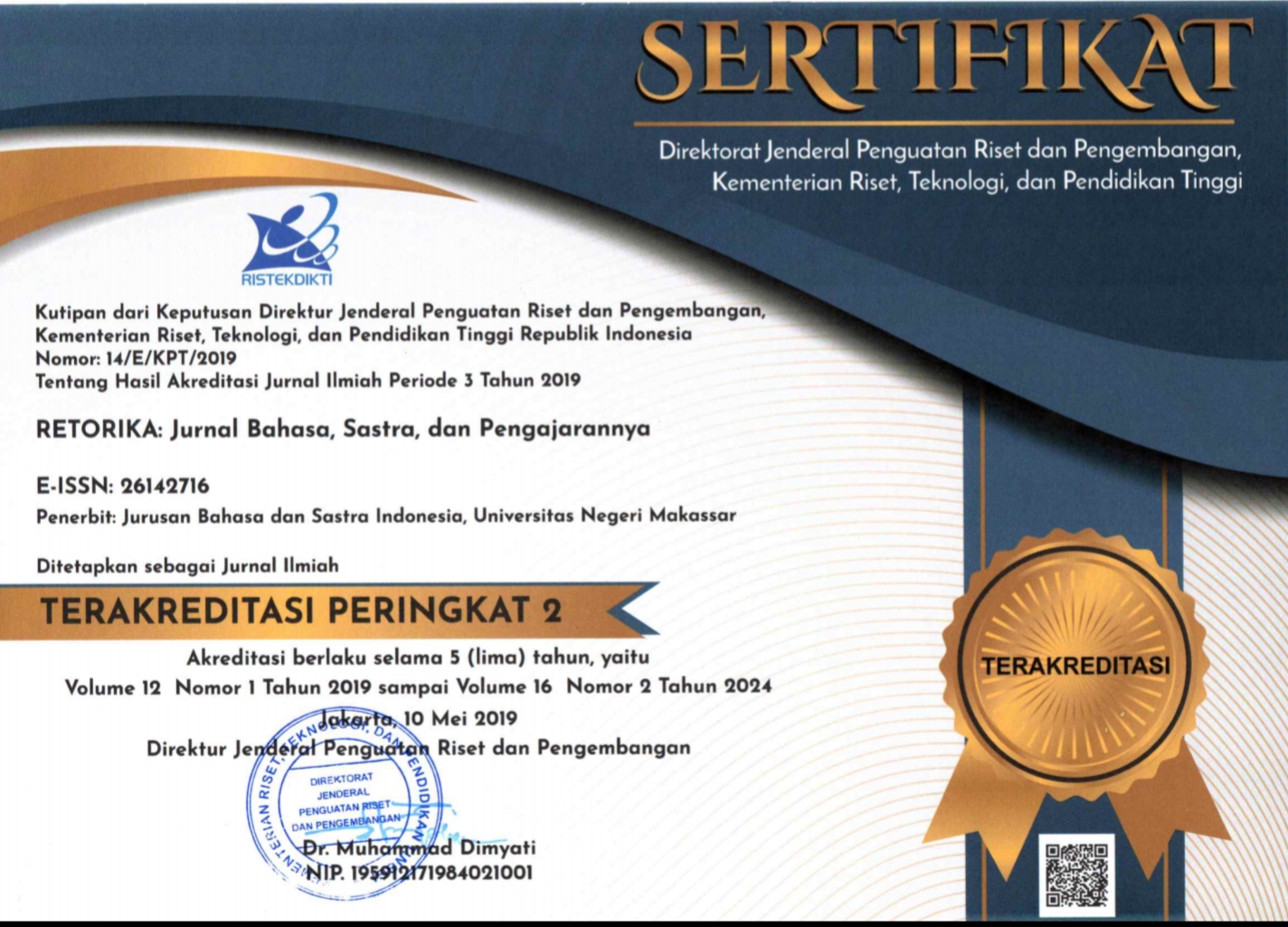THE STUDY OF THE NARRATOR IN HERMAN RN'S SHORT STORIES
(1) FKIP Syiah Kuala University
(2) wildan@fkip.unsyiah.ac.id
(3) wildan@fkip.unsyiah.ac.id
(*) Corresponding Author
DOI: https://doi.org/10.26858/retorika.v15i2.31849
Abstract
Keywords
Full Text:
PDFReferences
Ahmadian, M., & Jorfi, L. (2015). A Narratological Study and Analysis of: The Concept of Time in William Faulkner’s “A Rose for Emily.” Advances in Language and Literary Studies, 06(03).
Alda, R. E. P. (2020). Dr. Jekyll dan Mr. Hyde: Sebuah Penggambaran Dualisme Naluri Kehidupan dan Kematian. Adabiyyāt: Jurnal Bahasa Dan Sastra, IV(1), 1–22.
Aminuddin. (1995). Pengantar Apresiasi Karya Sastra. Sinar Baru.
Ardiana, Z., Nazaruddin, K., & Suyanto, E. (2014). Sudut Pandang Pencerita dalam Novel Padang Bulan Karya Andrea Hirata. Jurnal Kata (Bahasa, Sastra, Dan Pembelajarannya), April, 1–12.
Atmaja, J. (2020). Wacana Sastra dan Bukan Wacana Sastra dalam Perspektif Naratologi. Pustaka, Jurnal Ilmu-Ilmu Budaya, xv(01), 1–20.
Boyatzis, R. . (1998). Transforming Qualitative Information: Thematic Analysis and Code Development. Sage.
Creswell, J. W. (2016). Research Design Pendekatan Kualitatif, Kuantitatif, dan Mixed. Pustaka Pelajar.
Haryati, I. (2020). Perempuan Mandiri dalam Novel Bumi Manusia Karya Pramudya Ananta Toer dan Drama Mutter Courage Und Ihre Kinder Karya Bertolt Brecht. Iv(1), 66–91.
Hidayati, A. (2012). Gaya Solilokui dalam Kumpulan Cerpen Rectoverso Karya Dewi Lestari. State University of Malang.
Intan, T. (2018). Narator Sebagai Penyampai Kritik Sosial Dalam Novel Moha Le Fou Moha Le Sage Karya Tahar Ben Jelloun. Jurnal Ilmu Budaya, 6(2), 207. https://doi.org/10.34050/jib.v6i2.5037
Intan, T. (2020). Kompleksitas Struktur Naratif dalam Novel La Dentelliere Karya Pascal Laine. Jurnal Ilmu Budaya Dasar, 8(1972), 11.
Jung, J. (2020). Diagnosing causes of pre-service literature teachers’ misconceptions on the narrator and focalizer using a two-tier test. Education Sciences, 10(4). https://doi.org/10.3390/educsci10040104
Matradewi, N. K. W. (2018). Konstruksi Aku Dalam Diatesis Medial Refleksif Bahasa Indonesia Pada Novel Terjemahan. Adabiyyāt: Jurnal Bahasa Dan Sastra, 2(2), 202. https://doi.org/10.14421/ajbs.2018.02203
Nurgiyantoro, B. (2018). Teori Pengkajian Fiksi. Gadjah Mada Universty Press.
Palmer, R. E. (2005). Hermeneutika: Teori Baru Mengenai Interpretasi (Tr. Masnur Hery Damanhuri Muhammad). Pustaka Pelajar.
Panggabean, D. S., & Rangkuti, R. (2020). The Basic Concept of Narratology and Narrative. Language Circle: Journal of Language and Literature, 14(2), 184–190. https://doi.org/10.15294/lc.v14i2.23247
Pavelka, J. (2014). Narratology as an Interpretative Model, and a Narrative Analysis as an Interpretative Key of Basic Teaching Tools in Textbooks and in Data-Video Presentation – Static Visual Texts. Procedia - Social and Behavioral Sciences, 141, 934–939. https://doi.org/10.1016/j.sbspro.2014.05.162
Rismawati, Kasmi, H., & Bahry, R. (2018). Women’s Study in Aceh Novels inthe 21st Century, Indonesia. IOSR Journal of Humanities and Social Science, 23(6), 61–74. https://doi.org/10.9790/0837-2306086174
RN, H., & Idham, M. (2018). Sikap Sosial Kombatan dan Masyarakat Aceh Semasa Konflik (Kajian Mimesis Novel Sang Kombatan Karya Musa Am ). Perfeksional, 1(1), 73–78.
Semi, A. (1993). Anatomi Sastra. Angkasa Raya.
Shin, I. (2021). Mobility in The Work of Haruki Murakami, Focusing on Dance Dance Dance as a Narrative of Mobility. Kritika Kultura, 2021(36), 234–252. https://doi.org/10.13185/kk2021.03612
Sudjiman, P. (1992). Memahami Cerita Rekaan. Pustaka Jaya.
Sugiyono. (2013). Metode Penelitian Kuantitatif Kualitatif dan R&D. Penerbit Alfabeta.
Sutrisno, A. (2020). Narator dan Keberulangan Cerita dalam Film Perfume the Story of a Murderer. GHANCARAN: Jurnal Pendidikan Bahasa Dan Sastra Indonesia, 2(1), 1–7. https://doi.org/10.19105/ghancaran.v2i1.3190
Teeuw, A. (2003). Sastra dan Ilmu Sastra (III). Pustaka Jaya.
Trompenaars, T., Hogeweg, L., Stoop, W., & de Hoop, H. (2018). The Language of an Inanimate Narrator. Open Linguistics, 4(1), 707–721. https://doi.org/10.1515/opli-2018-0034
Waluyo, H. J. (1994). Pengkajian Cerita Fiksi. Sebelas Maret University Press.
Widayati, S., & Faruk H.T. (2020). Suara Narator pada Novel Ronggeng Dukuh Paruk Karya Ahmad Tohari. Jurnal Sosiohumanika, 13(01).
Wildan. (2010a). Doktrin Nasionalisme dalam Novel A. Hasjmy. Lingua, 05(02).
Wildan. (2010b). Nasionalisme : Kajian Novel a . Hasjmy. Masyarakat Indonesia, XXXVI(1), 173–196.
Wildan. (2020a). Kearifan Lokal dalam Novel Seulusoh Karya D. Kemalawati. Pendidikan Bahasa Dan Sastra, 1(2013), 7–24.
Wildan. (2020b). Nasionalisme dan Sastra: Doktrin, Misi, dan Teknik Penyampaian Nasionalisme dalam Novel A. Hasjmy. Unsyiah Press.
Article Metrics
Abstract view : 325 times | PDF view : 77 timesRefbacks
- There are currently no refbacks.
Copyright (c) 2023 Wildan Wildan

This work is licensed under a Creative Commons Attribution-NonCommercial 4.0 International License.
Published by:
Department of Indonesian Language, Faculty of Languages and Literature, Universitas Negeri Makassar in cooperate with Asosiasi Dosen Bahasa dan Sastra Indonesia (ADOBSI) and Ikatan Program Studi Pendidikan Bahasa dan Sastra Indonesia (IKAPROBSI).
Address: Department of Indonesian Language Office, DG Building Second Floor, UNM Parangtambung, Daeng Tata Raya Street, Makassar, South Sulawesi, Indonesia
 Email: retorika@unm.ac.id
Email: retorika@unm.ac.id

RETORIKA: Jurnal Bahasa, Sastra,dan Pengajarannya is licensed under a Creative Commons Attribution-NonCommercial 4.0 International License.
















